All profits to

Archive Home Page
Previous Exhibition Following Exhibition
St. Margaret's Hall, Coniston Road, Hatherley, Cheltenham, GL51 3NU
All profits to |  |
Descriptions are based on material supplied by the layout owners
American Grain American Grain is set somewhere on the great plains in the Midwest of the United States of America, it could be anywhere in this region, a typical scene from Iowa to Kansis or Missouri to Minnesota. Agriculture has always been one of the biggest drivers in the Midwest economy. The region's fertile soil combined with the steel plough has made it possible for farmers to produce abundant harvests of grain and cereal crops, including corn, wheat, soybeans, oats, and barley, the Midwest has become known as the nation's "breadbasket". My layout demonstrates the labour intensive movement of grain in the early 1970's before hoppers freight cars became commonplace. Grain was transported in sacks carried over the shoulders of men from freight car to lorry.
Setting my layout in the Midwest in this time period allows varied liveries of stock due to the wave of Railroad buyouts and take overs in this era of railroad deregulation. You are likely to see motive power from any of the large companies of the time or the numerious shortlines of the area. | 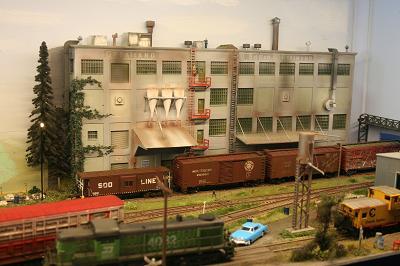 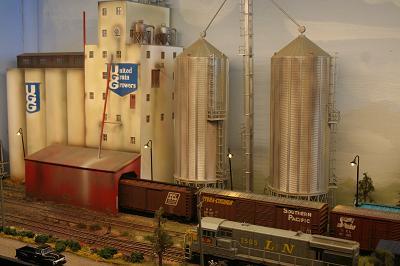 | |
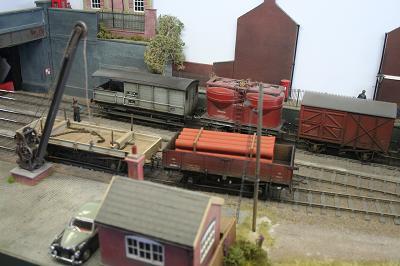 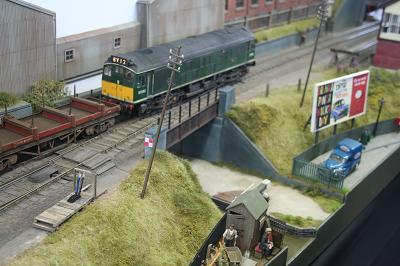 |
Bakewell Street is my first attempt at a standard gauge 7mm layout and is something of an experiment. It is a simple test track laid as an "Inglenook" or shunting twig and has been built using Peco track. It is designed to be extended if I wish and is still technically "unfinished". It has been further developed by including a sector plate at one end to provide a run-round loop, although the layout can still be operated simply, using the 8 foot scenic section. It is loosely based in the 1960's and depending on the stock run is located on the British Rail Western Region somewhere in the Gloucester area or on the London Midland Region on Merseyside. The layout is run with an NCE DCC system and the locomotives are sound chipped. The couplings are MSE Sprat and Winkle operated using both fixed and electo magnets. We try to operate "hands off" as much as we can. The locomotives are a mixture of kit-built and ready-to-run, the freight stock is mainly kit-built plastic and brass kits from Slater's, Parkside and Connoisseur. Soft scenery is mainly from Greenscene, with an additional layer of static grass. Low relief brick buildings are mainly Skytrex, with a number scratch built. There is a choice of two signal boxes, depending on region in operation on the day. The LNWR cabin is Lasercraft Devon, the Midland Region signal box is the former Churchward Models structure now made by Phoenix Models. For Walkerail 2017 my “plan” is to swap them overnight so LMR in Northwest on Saturday and WR around Gloucester on Sunday. | |
Banbury Banbury station is located on the busy cross country route midway between Birmingham and Didcot where the route combines with the Great Western mainline into Reading. The Chiltern Railways mainline towards London Marylebone diverges a few miles south of the town at Aynho Junction. There is a lot of freight traffic, mainly container trains heading to and from the deep sea terminal at Southampton. Chiltern Trains operate the majority of passenger services plus Cross Country have two trains an hour each way. First Great Western get in on the passenger action with a local service that terminates at Banbury. Until January 2011 there was also a locomotive that hauled Wrexham and Shropshire passenger trains operating into Marylebone. However Chiltern have now introduced locomotive hauled on weekdays between London and Birmingham. The non scenic section of the layout was built originally for a different model railway. So the scenic section for Banbury has had to be designed to fit within this fiddle yard. Peco fine scale code 55 track has been used with SEEP solenoids to operate the turnouts. All buildings have been scratch built from plastic sheet and are as close to size as can be achieved from scaling of photographs and from pacing out the walls. We have also used Google maps and Google Streets to check proportions and locations of buildings relative to each other. Rolling stock and locomotives have been detailed and are from a number of manufacturers such as Graham Farish and Dapol. Trains are controlled via Digitrax DCC system with turnouts operated via stationary decoders. All movements are made using ipods and iphones running an app called Wi throttle. This then communicates with the DCC system via a wireless router connected to a laptop that runs the free software JMRI. The laptop is connected to the DCC command station using an interface called Loco Buffer. Touch screen PC's are used for the track plan and turnout control and showing their status. | 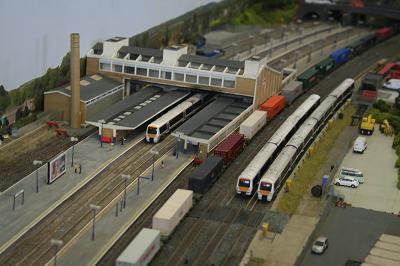 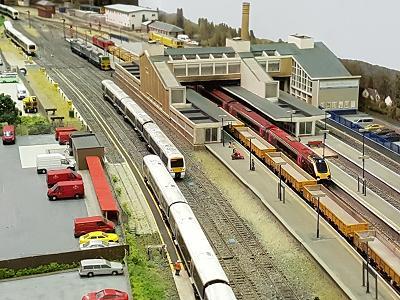 | |
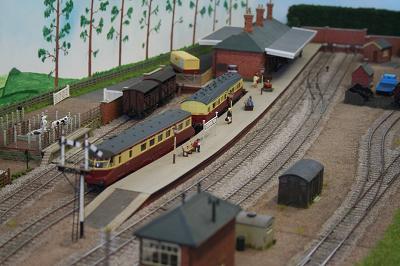 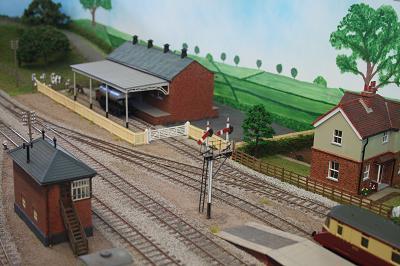 |
Two villages named Cherington actually exist in the Cotswold area, near Tetbury and to the north west of Hook Norton neither had railways. Branches could have been built from the Kemble to Tetbury line or the Banbury and Cheltenham line. This layout is fictitious but assumes a terminus has been constructed by the Great Western Railway, it is set in the British Railways era of mid 1950's to early 1960's. Traction is provided mainly by steam locomotives of the Western Region with perhaps the occasional interloper from elsewhere. In addition some early diesels and Diesel Multiple Units may be seen. The layout is built to 4mm scale and uses SMP finescale OO track for the scenic section and Peco OO for the traverser fiddle yard. The baseboards are built from 9mm plywood and are covered in cork to form the track base. Scenery is a mixture of textures using mainly Woodland Scenics scatter of electrostatic grass. The buildings are a mixture of plastic kits used for the engine shed, signal box and yard sheds. With a scratch built station building, station masters house, cremetary, goods shed and weighbridge. The cattle dock is the ratio kit modified to fit the location. | |
Hollow Fosse Hollow Fosse is a fictitious location in the south-west of the Cotswolds region. The layout represents a small rural branch line that connects with the former Midland and South Western Junction Railway. After being absorbed into the Great Western Railway (GWR) is still provided a useful link between the midlands and the south coast. Nationalisation allowed the mainline and its branches to settle into the slow rhythm of the countryside that it served. The layout endeavours to recreate the atmosphere of the late 1950's and early 1960's. The buildings many of which are modelled on actual structures, depict a typical Cotswold location. Locomotives and rolling stock are still a mixture of previous railway groups, GWR (Western), Southern and Midland including mixed trains which rationalised train movements. The layout which is L shaped has a dimensions of 5 feet by 3 feet and is operated from the rear of the 5 feet length. It is modelled on a 3mm to 1 foot scale, Triang TT. | 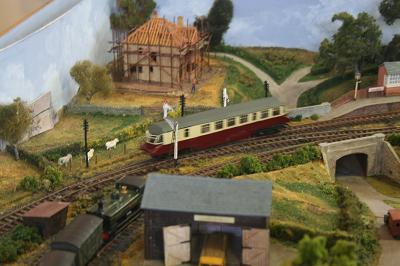 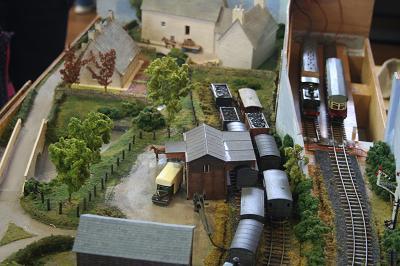 | |
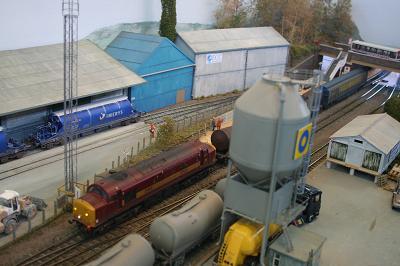 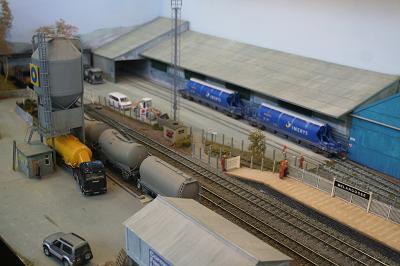 |
Melangoose is situated at the end of a single track branch that meets the Plymouth to Penzance Cornish mainline at Par. Originally opened in 1873 by the Cornwall Minerals Railway this branch line was built at the same time as the ones to Carbis and Treamble. It was a time of great expansion for the China Clay industry, with state of the art harbour loading facilities being built at Fowey and Newquay. The reason for the lines survival today is the busy China Clay Works. The timeframe for my model is circa 2003-2005. When EWS Class 66's were beginning to take over from the veteran Class 37's based at St Blazey shed. Passenger services remain and are operated by Wessex Trains, Class 150 and 153's can be seen on the sparse services that run from Lostwithial through Par and terminate at Melangoose. The layout was originally built by Dave Smart, with the intention that you could run anything from Steam to current day, the infrastructure on Cornish Branch lines has not changed for many decades, only now are changes starting to happen. Since purchased 5 years ago I have added some modern day signage, to set the period. Scenic section measures 5 foot 2 inches with a sector plate that is just over 3 feet long. Track plan has only 3 points, one in the China Clay Facility and two at the end of the platform road which form the run-round for freight. The other end of the run-round is made up by the traverser which feeds the track into the China Clay, platform track, run-round loop, Cement Depot and 3 hidden sidings to the rear of the layout. | |
Plank Lane The North Eastern Railway, N.E.R. opened its engine shed at Ferryhill, County Durham in 1881 to house a dozen or so goods engines, the allocation had risen to about twenty by the time of the Grouping in 1923. Two class G5 0-4-4 tank engines were added but numbers remained fairly consistent until 1935. At this point Ferryhill was given the allocation of motive power displaced by the closure of Shildon shed, however it only survived for two more years before closure. Ferryhill enjoyed a brief claim to fame during World War Two, when exhibits from the National Railway Museum at York were sent for safe keeping. For my modelling purposes there was, of course, a second, but completely fictitious, locomotive shed at Ferryhill, called Plank Lane. This shed was built on a site originally occupied by the York, Newcastle and Berwick Railway which was taken over by the N.E.R in 1854. The depot being retained and enlarged to house freight locomotives used to service the coalfields of County Durham and North Yorkshire. Unlike its counterpart, Plank Lane survived much longer, mainly due to its location in the triangle formed by the lines to Stockton and Darlington that gave better access to diverging routes. When the locomotives allocation increased at Plank Lane, it was decided to provide a turntable. Land was acquired in 1937 and by late 1938 a 70 foot vacuum tractor turntable had been installed. Plank Lanes reasonable proximity with Darlington works, to the south meant that it could also be used by locomotives on running in turns after attention at the works, therefore allowing a variety of motive power to be seen visiting the depot for checking and servicing before returning to the works. The scene you see is set around 1946 when the LNER was embarking on a renumbering scheme. Some locomotives can be seen newly re-numbered while others awaited such attention. The shed roof was damaged by fire and has been removed awaiting replacement, while other parts of the depot have recovered a little from wartime austerity. | 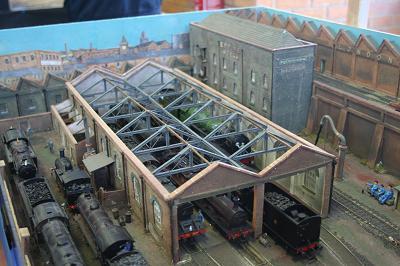 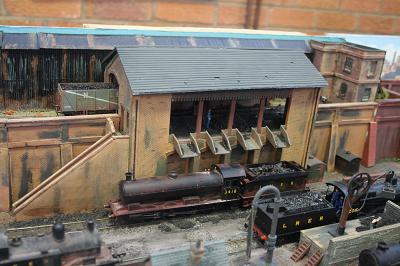 | |
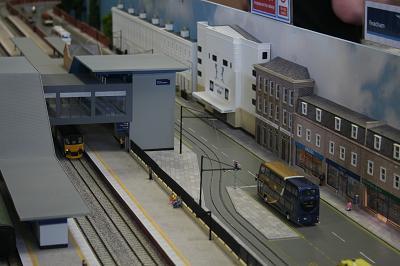 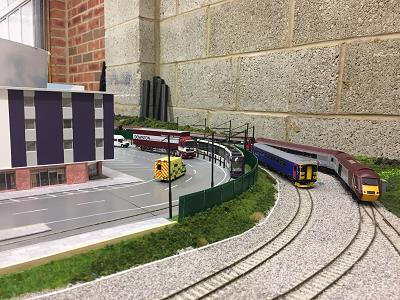 |
Readham the model layout has been inspired by a combination of the conurbations of Reading and Cheltenham. Buildings are scratch built, there is a traditional Regency inspired residential and shopping area, plus a modern retail park. The station complex includes a full station with four platforms. A modern Bombardier Flexity 2 tram can be seen running through the streets and shopping areas. Other scenic highlight features include a Showman's winter quarters with working drop tower ride and transport park with pulled down rides. Trains are modern image and DCC controlled and include sound. | |
Thomas We would like to thank Trevor Hallam for looking after the Thomas Layout for many years at our exhibitions and also for refurbishing it at his expense. Unfortunately because of ill health Trevor is no longer able to continue so it was decided to offer Thomas free of charge to Hucclecote Railway Modellers on condition they bring it to all of our future exhibitions. This is the model railway where Children can become Engine Drivers on the Island of Sodor and has of course been inspired by the Reverend Audrey books. Our Thomas and Friends layout has been built for ten years now and in that time we hope it has encouraged many new railway enthusiasts to build a train set of their own. Originally it was intended as a space filler at shows so needed to be small, easy to transport and have a simple track plan, easy for small children to operate. After its first appearance it was clear this model railway would have to be included at all our exhibitions. It incorporates a tunnel, station, level crossing together with locomotive and goods facilities. Train drivers should look out for many of the popular characters; Henry, Percy, Toby, Cranky, the Troublesome Trucks, not forgetting the Sir Topham Hatt better known as the Fat Controller. The famous anthropomorphised rolling stock is mostly from the Thomas range and we are sure most of the adults and all the kids will love it. Happy Driving, but please observe the track speed limits. | 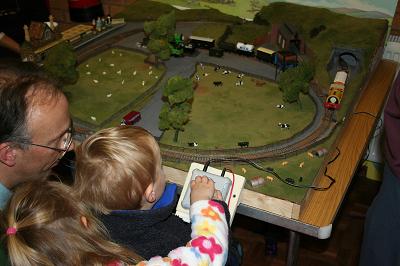 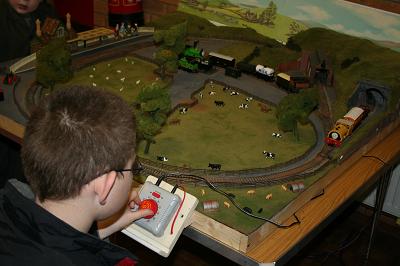 | |
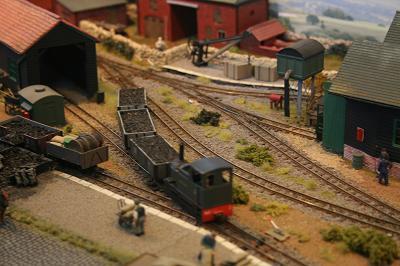 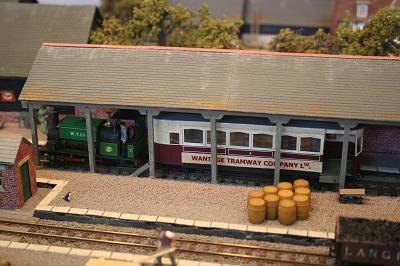 |
The Wantage Tramway was a standard gauge railway that linked the market town of Wantage in Oxfordshire to the GWR mainline which was two and a half miles from the town. The tramway had some very unusual locomotives and rolling stock for a British railway, and the train shed is also pretty unique. Unusually the small engine shed straddled the sidings that fed the local gas works. The layout is Richard's interpretation of what the Upper Yard at Mill Street might have looked like, had the tramway been built as a 2 foot 3 inch narrow gauge line. Richard does not claim that this is an accurate model of the terminus, but he hopes that it does give an impression of the area in the 1920's. Originally the tramway closed to passengers in 1925, but goods traffic continued until December 1945. The railway buildings are accurate models of the originals, apart from window size and style. Here Richard has used plastic windows that he happened to have in stock. Some of the other buildings have also been scratch built using card and plastic. Models from the Hornby Skaledale and the Bachmann Scenecraft ranges have also been used. The two main tram locomotives, Hughes tram number 4 and the Matthews tram number 6, have been built using Worsley Works brass etches. The models run on Kato 9mm gauge tram chassis. The three tram cars, numbers 3, 4 and 5 have also been built using Worsley Works brass etches, each of these run on a Kato N gauge bogie chassis. Wantage Tramway Manning locomotive number 7 is represented by an RT Models standard gauge kit running on an adapted Graham Farish 08 diesel N gauge chassis built by the late Pete Wallace. There are two back-up tram locomotives which can be used at exhibitions, One was built by Paul Windle and Richard built the other using a 3D printed body from Chris Ward. Other rolling stock has been constructed from plastic kits of various prototypes from Great Britain and Ireland. Some have been built as the manufacturers intended, other have been modified considerably by mixing various kit parts and altering width and length of vehicles. | |
Westbridge Westbridge is a fictitious exhibition layout based on the Western Region during British Rail's blue diesel era in the early 1970's. It is modelled in OO gauge and includes a small terminus station, sidings and a scratch built three road traction maintenance depot. The track is Peco Code 75, control is DCC via a NCE Powercab.
Locomotives are a mixture of Bachmann and Heljan and the majority of rolling stock in Bachmann. Since it was last at the Cheltenham show, the layout has been extended by three feet, this gives me much more operational interest whilst exhibiting. Regular passenger services terminate and depart from Westbridge, these are operated either multiple unit or mk1 carriage stock. There are also occasional parcel trains, which can also be either locomotive hauled or operated by units. A station pilot is always present and occasionally shunts stock sitting at the platforms. Westbridge Traction Maintenance Depot is always busy. Operations including light engine movements or oil tankers, which serves the fuelling point. We hope you enjoy Westbridge as this is my first attempt at an exhibition layout that I built at the age of fifteen. | 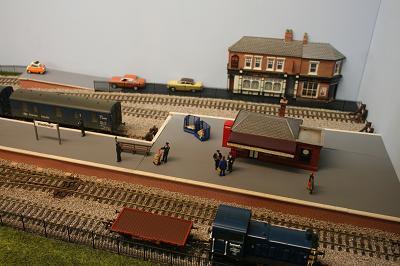 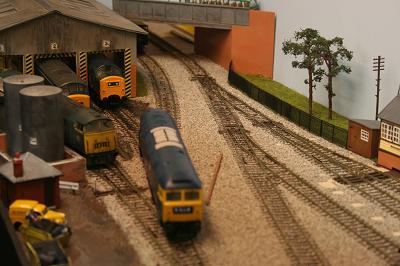 | |
| Displays | ||
Model Bus Federation WEBSITE | NARTM (road transport) WEBSITE | |
Travel 2000 Ltd | Capital Works WEBSITE | |
Mini scenes | Tanks and Total War WEBSITE | |
Abbotswood - the back room story | ||
| Modelling Demonstrations | ||
| Mark Begley | Richard Bucknall | |
| Steve Harrod | Trevor Hale | |
| Trade | ||
| Cheltenham Model Centre WEBSITE | Derails Models WEBSITE | |
| RCSW (Pre-owned) Models, Clive Reid | Rly books, timetables, photos, Stewart Blencowe WEBSITE | |